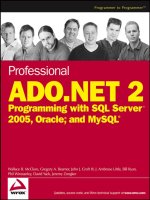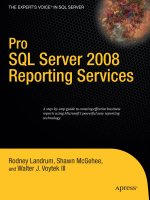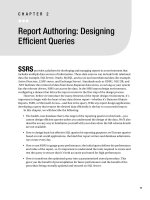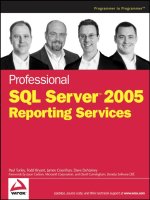MasteringSQL Server 2005 Reporting Services Infrastructure Design docx
Bạn đang xem bản rút gọn của tài liệu. Xem và tải ngay bản đầy đủ của tài liệu tại đây (8.3 MB, 507 trang )
Mastering
SQL Server
TM
2005
Reporting Services
Infrastructure Design
Joseph Jorden
Wiley Publishing, Inc.
Mastering
SQL Server
TM
2005
Reporting Services
Infrastructure Design
Mastering
SQL Server
TM
2005
Reporting Services
Infrastructure Design
Joseph Jorden
Wiley Publishing, Inc.
Acquisitions Editor: Tom Cirtin
Development Editor: Dick Margulis
Technical Editor: Evangelos Petroutsos
Production Editors: Sarah Groff-Palermo and Michael Gordon
Copy Editor: Liz Welch
Production Manager: Tim Tate
Vice President and Executive Group Publisher: Richard Swadley
Vice President and Executive Publisher: Joseph B. Wikert
Vice President and Publisher: Neil Edde
Book Designers: Judy Fung and Bill Gibson
Proofreader: Ian Golder
Indexer: Ted Laux
Anniversary Logo Design: Richard Pacifico
Cover Designer: Ryan Sneed
Cover Image: Pete Gardner/Digital Vision/Getty Images
Copyright 2007 by Wiley Publishing, Inc., Indianapolis, Indiana
Published simultaneously in Canada
ISBN-13: 978-0-470-11459-9
No part of this publication may be reproduced, stored in a retrieval system, or transmitted in any form or by any means, electronic,
mechanical, photocopying, recording, scanning, or otherwise, except as permitted under Sections 107 or 108 of the 1976 United States
Copyright Act, without either the prior written permission of the Publisher, or authorization through payment of the appropriate
per-copy fee to the Copyright Clearance Center, 222 Rosewood Drive, Danvers, MA 01923, (978) 750-8400, fax (978) 646-8600.
Requests to the Publisher for permission should be addressed to the Legal Department, Wiley Publishing, Inc., 10475 Crosspoint
Blvd., Indianapolis, IN 46256, (317) 572-3447, fax (317) 572-4355, or online at />Limit of Liability/Disclaimer of Warranty: The publisher and the author make no representations or warranties with respect to
the accuracy or completeness of the contents of this work and specifically disclaim all warranties, including without limitation
warranties of fitness for a particular purpose. No warranty may be created or extended by sales or promotional materials. The advice
and strategies contained herein may not be suitable for every situation. This work is sold with the understanding that the publisher
is not engaged in rendering legal, accounting, or other professional services. If professional assistance is required, the services of a
competent professional person should be sought. Neither the publisher nor the author shall be liable for damages arising herefrom.
The fact that an organization or Website is referred to in this work as a citation and/or a potential source of further information does
not mean that the author or the publisher endorses the information the organization or Website may provide or recommendations it
may make. Further, readers should be aware that Internet Websites listed in this work may have changed or disappeared between
when this work was written and when it is read.
For general information on our other products and services or to obtain technical support, please contact our Customer Care
Department within the U.S. at (800) 762-2974, outside the U.S. at (317) 572-3993, or fax (317) 572-4002.
Wiley also publishes its books in a variety of electronic formats. Some content that appears in print may not be available in
electronic books.
Library of Congress Cataloging-in-Publication Data is available from the publisher.
TRADEMARKS: Wiley, the Wiley logo, and the Sybex logo are trademarks or registered trademarks of John Wiley & Sons, Inc.
and/or its affiliates, in the United States and other countries, and may not be used without written permission. Microsoft and
SQL Server are trademarks or registered trademarks of Microsoft Corporation in the United States and/or other countries. All
other trademarks are the property of their respective owners. Wiley Publishing, Inc., is not associated with any product or vendor
mentioned in this book.
10987654321
DearReader
Thank you for choosing Mastering SQL Server 2005 Reporting Services Infrastructure Design.
This book is part of a family of premium quality Sybex books, all written by outstanding authors
who combine practical experience with a gift for teaching.
Sybex was founded in 1976. More than thirty years later, we’re still committed to producing
consistently exceptional books. With each of our titles we’re working hard to set a new standard
for the industry. From the paper we print on, to the authors we work with, our goal is to bring you
the best books available.
I hope you see all that reflected in these pages. I’d be very interested to hear your comments
and get your feedback on how we’re doing. Feel free to let me know what you think about this
or any other Sybex book by sending me an e-mail at nedde.com, or if you think you’ve found
a technical error in this book, please visit . Customer feedback is
critical to our efforts at Sybex.
Best regards,
Neil Edde
Vice President and Publisher
Sybex, an Imprint of Wiley
With love to my wife, Rachelle
Acknowledgments
Over the past decade or so, I’ve worked on a number of books and articles. None of them has been
easy, but they have all been rewarding. This book is no exception; it has taken a lot of work from a
lot of people who deserve a lot of praise. First, I want to thank Tom Cirtin at Sybex, for introduc-
ing me to this project to begin with, and Dick Margulis, who kept everything running smoothly
after the project got under way. Special thanks to Evangelos Petroutsos, who did double-duty
as the technical editor and the contributor of three chapters in the book. I would also like to thank
the production editors, Sarah Groff-Palermo and Michael Gordon, copy editor Liz Welch, and
proofreader Ian Golder.
Writing books takes time from personal as well as work-related activities, and I have had a
number of friends help me through this book. I have to start by thanking my mother, Mary Jorden,
along with the rest of my immediate family: Buddy and Shelly Jorden, and Janet, Colin, and Leian
McBroom. Thanks to all of you. Also, thanks to some special people who have unwittingly taken
on the task of keeping me sane through all of this (well, as close as I can come, anyway). Thanks
to Jyles McDonald for the early mornings. To Dave Moody back at Jelly Belly; IOU, LE. Tristan
and Amanda Williams, thanks for making me feel good about myself at pool. Most important,
special thanks to my wife, Rachelle Jorden, who once again sacrificed a lot of time so that I could
write another book. And finally, thanks to all of you out there for reading this book; may it serve
you well.
Contents at a Glance
Introduction xvii
Part 1
•
Designing the Reporting Infrastructure 1
Chapter 1
•
Principles of a Reporting Infrastructure 3
Chapter 2
•
Determining Business Requirements 15
Chapter 3
•
Planning and Developing Role-Based Security 35
Chapter 4
•
Managing User Expectations 61
Chapter 5
•
Change Management 75
Chapter 6
•
Business Intelligence and Reporting 85
Part 2
•
Using Reporting Services in Your Infrastructure 113
Chapter 7
•
Deploying Reporting Services 115
Chapter 8
•
Ad Hoc Reporting 139
Chapter 9
•
Subscriptions 163
Chapter 10
•
Maintenance and Administration 185
Part 3
•
Advanced Topics 215
Chapter 11
•
Managing Reports Using Program Code 217
Chapter 12
•
Extending Reporting Services 245
Chapter 13
•
Report Definition Language 267
Chapter 14
•
Report Server Security 299
Chapter 15
•
Data Sources and Data Sets 315
Chapter 16
•
Performance Tuning 335
Index 463
Contents
Introduction xvii
Part 1
•
Designing the Reporting Infrastructure 1
Chapter 1
•
Principles of a Reporting Infrastructure 3
Reporting Infrastructure Basics 3
What Is a Reporting Infrastructure? 3
Do You Need a Reporting Infrastructure? 5
Why Use Reporting Services 6
What Reporting Services Can Do for You 7
Inside Reporting Services 8
Licensing Reporting Services 11
The Bottom Line 13
Chapter 2
•
Determining Business Requirements 15
Determining Current Business Requirements 16
Understanding the Current Business Model 17
Analyzing Business Processes 17
Analyzing the Company Model and Geographic Scope 20
Analyzing Organizational Structures 21
Identifying New Business Requirements 24
Gathering Accurate User Requirements 25
Identifying Key Project Stakeholders 26
Determining Business Priorities 26
Determining Risk Tolerance 27
Creating a Scope Document 27
Identifying Internal and External Dependencies 28
Creating Data-Flow Diagrams 29
Assessing Training Needs 29
Determining Regulatory Requirements 30
Defining Report Requirements 31
Planning for the Future 32
Accurate Prognostication 33
The Bottom Line 34
Chapter 3
•
Planning and Developing Role-Based Security 35
Planning Role-Based Security 35
Gathering Security Requirements 36
Setting Security Scope 37
xii CONTENTS
Analyzing Your Security Requirements 37
Dealing with Conflicting Requirements 38
Analyzing the Costs, Benefits, and Risks of Requirements 39
Implementing Role-Based Security 40
Understanding Securable Items 41
Understanding Tasks and Permissions 41
Understanding Role Definitions 44
Creating Role Assignments 52
Exploring Minimum Access Permissions 58
The Bottom Line 59
Chapter 4
•
Managing User Expectations 61
Understanding Your Users 62
Communicating with Your Users 63
Communicate Early and Often 63
Be Honest and Forthright 65
Educate Your Users 65
Prototyping and Storyboarding 66
Training Classes 68
Listen to Your Users 70
Using Service-Level Agreements 71
Preparing the SLA 72
Writing Documentation for Users 73
The Bottom Line 74
Chapter 5
•
Change Management 75
Understanding Change-Management Theory 75
Unfreezing/Changing/Refreezing 76
ADKAR 76
Putting Change Management into Practice 77
Understanding Management’s Role 77
Necessary Skills for You 79
Change-Management Strategies 82
Managing Ongoing Change 83
The Bottom Line 84
Chapter 6
•
Business Intelligence and Reporting 85
Business Intelligence in SQL Server 2005 85
Online Analytical Processing 86
Data Mining 88
Installing and Configuring Analysis Services 88
Installing Analysis Services 89
Creating and Configuring a Project 92
Creating a Cube 96
Creating a Report Based on a Cube 98
CONTENTS xiii
Creating a Report Based on a Data-Mining Model 103
Creating a Data-Mining Model 103
Creating a Report Based on a Data-Mining Model 106
The Bottom Line 111
Part 2
•
Using Reporting Services in Your Infrastructure 113
Chapter 7
•
Deploying Reporting Services 115
Planning a Reporting Services Deployment 116
Standard Deployments 116
Scaled-Out Deployments 120
Playing Nice with SharePoint 125
Automating Deployment 129
Automating the Installation and Configuration Steps 129
Postdeployment Configuration 132
Custom Authorization Cookies 132
Advanced E-mail Delivery Settings 133
Internet Access 135
A Deployment Checklist 136
The Bottom Line 137
Chapter 8
•
Ad Hoc Reporting 139
Preparing the Systems 139
Preparing the Clients 139
Preparing the Servers 140
Working with Report Models 143
Using Model Designer 144
Using Report Manager and Management Studio 156
Using Report Builder 158
Creating and Designing Reports 158
The Bottom Line 161
Chapter 9
•
Subscriptions 163
Understanding Subscriptions 164
Configuring the Servers 165
Configuring a File Share 165
Configuring E-mail Delivery 165
Configuring the Default Delivery Extension 167
Creating Subscriptions 168
Standard 169
Data Driven 172
SharePoint Integrated 179
Managing Subscriptions 180
Preloading the Report Cache 181
The Bottom Line 183
xiv CONTENTS
Chapter 10
•
Maintenance and Administration 185
Managing the Report Server 186
Administering the Services 186
Performing Backups 189
Managing Encryption Keys 195
Managing Processing and Content 197
Report Settings 198
My Reports 199
Managing Resources 199
Managing Folders 201
Managing a Running Process 201
Troubleshooting 202
Working with Log Files 202
Tips for Common Problems 207
The Bottom Line 212
Part 3
•
Advanced Topics 215
Chapter 11
•
Managing Reports Using Program Code 217
Accessing Reports from within Your Code 217
Accessing Reports with a URL 218
Viewing Reports 218
Using the rs:Command Parameter 220
The rs Utility 221
Using the rc Parameters 223
Passing Report Parameters in a URL 224
The Report Server Web Service 225
Accessing the Report Server from within .NET Applications 226
Selected Management Methods 231
Selected Execution Methods 236
Specifying Device Information Settings 240
The Bottom Line 243
Chapter 12
•
Extending Reporting Services 245
Understanding Extension Types 246
Building a Security Extension 246
The IAuthenticationExtension Interface 247
The IAuthorizationExtension Interface 250
Deploying a Custom Security Extension 254
Building a Data Processing Extension 258
The IDbCommand Interface 259
The IDbConnection Interface 260
The IDataReader Interface 261
Deploying a Data Processing Interface 263
Deploying a Data Processing Extension to Report Designer 264
The Bottom Line 265
CONTENTS xv
Chapter 13
•
Report Definition Language 267
What’sinanRDLFile 267
The Structure of an RDL File 269
Creating a Report Definition File 272
Deploying the New Report 279
Specifying Report Parameters 280
Creating Reports in Code 281
Embedding Images 287
Exploring the RDL Elements 289
The Report Element 289
The EmbeddedImage Element 289
The ReportParameters Element 290
The ReportParameter Element 290
The ParameterValue Element 290
The DataSet Element 290
The Fields Element 290
The Field Element 291
The Query Element 291
The QueryParameters Element 291
The QueryParameter Element 291
The DataSources Element 291
The DataSource Element 291
The Body Element 292
The PageHeader Element 292
The PageFooter Element 292
The Table Element 293
The TableColumns Element 293
The TableColumn Element 293
The Header Element 293
The Footer Element 293
The TableGroups Element 294
The TableGroup Element 294
The Details Element 294
The TableRows Element 294
The TableRow Element 294
The TableCells Element 294
The TableCell Element 295
The Textbox Element 295
The Image Element 295
The Style Element 295
Global Variables 296
The Bottom Line 296
Chapter 14
•
Report Server Security 299
Authentication 299
Types of Authentication 300
xvi CONTENTS
Configuring Report Server for SSL 301
Changing Service Accounts and Passwords 303
Authorization 305
Securing Folders 307
Securing Models 308
Securing My Reports 311
Preventing SQL Injection Attacks 312
The Bottom Line 313
Chapter 15
•
Data Sources and Data Sets 315
Defining Report Data Sources 315
Creating a Shared Data Source 317
Using Data Source Expressions 321
Defining Report Data Sets 321
SQL Server Relational Database Data Sets 322
Analysis Services Data Sets 323
SQL Server Integration Services Data Sets 327
XML Data Sets 328
Oracle Relational Database Data Sets 329
SAP Relational Database and NetWeaver BI System Data Sets 330
Hyperion Essbase Data Sets 332
Report Model Data Sets 332
The Bottom Line 333
Chapter 16
•
Performance Tuning 335
Using the Performance Console 335
Modifying Configuration Files 343
ReportingServicesService 343
RSReportDesigner 343
RSWebApplication 346
RSReportServer 348
Tips and Techniques 356
Setting a Measurement Baseline 356
Data Archiving and Trend Tracking 356
Manually Configuring Available Memory 356
The Bottom Line 357
Appendix A
•
359
Appendix B
•
SharePoint Integration 391
Appendix C
•
Report Server Web Service Reference 417
Index 463
Introduction
Reporting Services was introduced with SQL Server 2000, and it quickly gained popularity
because it was easy to work with and it came free with SQL Server 2000.
A lot has changed since its initial release over seven years ago. Several new features make
Reporting Services easier to use and more functional:
X Reporting Services now allows users to create their own reports using the Report Builder
application.
X Developers can create reports, report models, and other SQL Server–related projects using
the new Business Intelligence Development Studio, which is based on the familiar Visual
Studio interface.
X There are several new tools for administrators to use in configuring the report server,
such as SQL Server Reporting Services Configuration Tool, the SQL Server Surface Area
Configuration Tool, and SQL Server Management Studio.
With all of the changes, a lot has stayed the same. For instance, Report Manager is still the pri-
mary interface for end users and administrators alike, and it looks almost the same in
this version.
The Report Server is still separated into two separate services: the Windows service and the
Web service. The Windows service still provides encryption and scheduling services, and the Web
service still handles ad hoc requests and serves up the API to developers.
And here’s the really good news: everything you’ve written in the previous version of
Reporting Services will still work in the new version. All of your reports will still render, your
subscriptions will still run, your custom extensions will still function — everything will still work
after the upgrade.
There is a lot more to Reporting Services than just this basic list, though, and you will be
exposed to the various functions and proceduresinthisbook.Whetheryou’veworkedwith
Reporting Services previously or this is your first time, you are going to be impressed with what
this new version can do.
How this Book is Organized
We’ve designed this book to be a reference for the user new to Reporting Services or the
experienced user who might want to see what’s new in this version. The emphasis is not just
on getting up and running, but on making sure that you do it right the first time. We don’t try
to cover every nook and cranny of the system, because that would take a much larger book. We
have, instead, provided you with the essential information you will need to get oriented with the
product and get it running in your environment.
xviii INTRODUCTION
The book is divided into three parts:
Part 1 (Chapters 1–6) Part 1 is designed to help you craft a project plan for deploying
Reporting Services in your enterprise. You will learn what makes a reporting infrastructure,
how to determine business requirements for the new reporting system, and how to manage
change during the deployment. There is also a section on role-based security so that you can
plan the security for your new system before you even install it.
Part 2 (Chapters 7–10) Part 2 helps you to take all of the theory from Part 1 and put it into
practice. In Part 2 you will learn how to deploy your reporting infrastructure based on the
plans you’ve drawn up in Part 1. You will learn how to manage report models for users to
create ad hoc reports and how to create subscriptions. There is also a chapter on managing
and troubleshooting Reporting Services.
Part 3 (Chapters 11–16) Part 3 digs into the more advanced Reporting Services topics. You
will learn how to program for Reporting Services by accessing the API. You will also get an
in-depth view of the XML language that reports are made from, the Report Definition
Language. There are also discussions on security, data sources and data sets, and Report
Server maintenance.
How to Contact the Author
As the old saying goes, nobody’s perfect. So, while we have tried to make this book as accurate
as possible, there will inevitably be the occasional mistake. There will be updates, service packs,
and release versions that change this software. If something strikes you as odd, or you find an
error in the book, please drop me a line via e-mail at ; I’m always happy
to hear from my readers.
Part 1
Designing the Reporting
Infrastructure
When most of us get a new piece of software, we are anxious to install
it right away and start playing with it. With Reporting Services, it
is best to quell that inclination because we have a lot of preparation
work to do first.
In this part, we will discuss what you need to do before installing
the software so that you get a usable reporting infrastructure that
everyone in the company can be happy with.
There are six chapters in this section:
X Chapter 1: Principles of a Reporting Infrastructure
X Chapter 2: Determining Business Requirements
X Chapter 3: Planning and Developing Role-Based Security
X Chapter 4: Managing User Expectations
X Chapter 5: Change Management
X Chapter 6: Business Intelligence and Reporting Services
Chapter 1
Principles of a Reporting
Infrastructure
Businesses can’t be run without some kind of reporting system. Management needs to know what
is going on in the company in order to make accurate business decisions, so they need reports.
Because you are reading this book, it is obvious that you are considering Reporting Services to get
those reports out.
Before you can make a solid decision, you must know what you are looking into. What is
Reporting Services and what can it do for you from a business perspective?
In this chapter we will:
X Define a reporting infrastructure
X Figure out why an enterprise-reporting infrastructure is necessary
X Help you decide if you need to use Reporting Services as your reporting infrastructure
Reporting Infrastructure Basics
Before you can decide whether to spend all of the time and money necessary to construct a
reporting infrastructure, you need to know what one is and how it is used.
What Is a Reporting Infrastructure?
This sounds like a simple question, but it is more involved than it seems. You may think of a
reporting infrastructure as any old type of reporting system that your business may use — from
pen and paper to colossal database systems. But there is more to it than that.
A reporting infrastructure is not only the data source but also the mechanism that displays the
report in a human-readable format, as shown in Figure 1.1. For instance, if you keep a grocery list
in your head and you need someone to go to the store for you to pick some things up, you write
down a list of what you need. The data source is the list you keep in your head, and the pen and
paper are the mechanism used to display the report in human-readable format.
Of course, most modern reporting infrastructures are considerably more complex than that.
Businesses use a variety of systems, depending on the data they keep and their reporting needs.
Some may use a simple spreadsheet to tally sales at the end of the day, some may use a Microsoft
Access database with custom reports, and others may use an enterprise-reporting system. That is
where Reporting Services starts to make sense.
An enterprise-reporting infrastructure like Reporting Services is used to display information
from disparate data sources in a format that people can understand and use in making business
decisions. What does that mean? Let’s consider an example.
4 CHAPTER 1 PRINCIPLES OF A REPORTING INFRASTRUCTURE
Figure 1.1
An enterprise-reporting
infrastructure is used
to combine data from
different sources into a
human-readable format.
Oracle 9
i
Data
Source
SQL Server 2005
Data Source
Report Server
Final Report
Most large companies have a number of databases that contain data for different departments
and different purposes. Human Resources may have a database for keeping track of employee
records, the Maintenance department may have a database for keeping track of equipment,
and so on.
Management needs to keep track of which employees have what equipment so that when
someone gets promoted they can get new equipment needed for their new position. Or, if someone
gets terminated, management can get all of the equipment back from that employee.
Maintenance does not have any records of who gets promoted or terminated in their database,
and Human Resources does not keep track of equipment in their database, so by themselves these
databases are not useful for tracking equipment based on employee status.
However, if you use an enterprise-reporting system, you can retrieve data from both of these
data sources and combine them into a single report that helps management see which employees
have what equipment and what needs to be done with that equipment.
Now let’s go one step further. Human Resources may have a system that uses Microsoft SQL
Server 2005 for data storage and Maintenance may use Oracle 9i for storing data. No problem.
An enterprise-reporting system can combine data not only from different data sources but also
from different vendors. That is what a reporting infrastructure is used for, but do you
need one?









